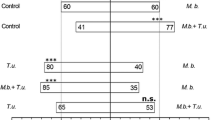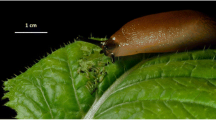Abstract
By analyzing the volatiles from Tetranychus urticae-infested kidney bean plants (Phaseolus vulgaris) at different times for two days, we found that they were mainly produced in the light. Tetranychus urticae showed a higher oviposition rate and spent more time feeding during the day (in the light) than at night (in the dark). Infested leaves placed in the light attracted the predatory mite Amblyseius womersleyi, whereas those that were placed in the dark for at least 2 h in daytime did not. This indicates that presence or absence of light affects the production of herbivore-induced plant volatiles. Amblyseius womersleyi dispersed more frequently and consumed more T. urticae eggs during the day (in the light) than at night (in the dark), whereas their oviposition rate did not differ between day and night. Presence or absence of herbivore-induced plant volatiles in the surroundings did not affect dispersal, predation or oviposition rates of A. womersleyi. These results show that A. womersleyi’s behavior coincides with the production pattern of herbivore-induced plant volatiles.
Similar content being viewed by others
References
Bancroft, J.S. and Margolies, D.C. 1996. Allocating time between feeding, resting and moving by the two-spotted spider mite, Tetranychus urticae and its predator Phytoseiulus persimilis. Exp. Appl. Acarol. 20: 391–404.
Dicke, M. 1999. Are herbivore-induced plant volatiles reliable indicators of herbivore identity to foraging carnivorous arthropods? Entomol. Exp. Appl. 91: 131–142.
Dicke, M., van Beek, T.A., Posthumus, M.A., Dom, N.B., van Bokhoven, H. and de Groot, A. 1990. Isolation and identification of volatile kairomone that affects acarine predator-prey interaction: Involvement of host plant in its production. J. Chem. Ecol. 16: 381–396.
Dobson, H.E.M. 1994. Floral volatiles in insect biology. In: Insect-Plant Interactions. Vol. V, E.A. Bernays (ed.), pp. 47–81, CRC Press, Florida.
Fisher, R.W. 1967. Diel periodicity in sensitivity of Tetranychus urticae (Acarina: Tetranychidae) to dicofol. Can. Entomol. 99: 281–284.
Hamamura, T. 1986. Studies on the biological control of kanzawa spider mite, Tetranychus kanzawai Kishida, by the chemical resistant predacious mite, Amblyseius longispinosus (Evans) in tea fields (Acarina: Tetranychidae, Phytoseiidae). Bull. Fruit Tree Res. Inst. Tea. 21: 122–197. (in Japanese with English summary).
Loughrin, J.H., Manukian, A., Heath, R.R., Turlings, T.C.J. and Tumlinson, J.H. 1994. Diurnal cycle of emission of induced volatile terpenoids by herbivore-injured cotton plants. Proc. Natl. Acad. Sci. USA. 91: 11836–11840.
Maeda, T., Takabayashi, J., Yano, S. and Takafuji, A. 1999. Response of the predatory mite, Amblyseius womersleyi (Acari: Phytoseiidae), toward herbivore-induced plant volatiles: variation in response between two local populations. Appl. Entomol. Zool. 34: 449–454.
Polcik, B., Nowosielski, J.W. and Naegele, J.A. 1965. Daily rhythm of oviposition in the two-spotted spider mite. J. Econ. Entomol. 58: 467–469.
Takabayashi, J. and Dicke, M. 1992. Response of predatory mites with different rearing histories to volatiles of uninfested plants. Entomol. Exp. Appl. 64: 187–193.
Takabayashi, J. and Dicke, M. 1996. Plant-carnivore mutualism through herbivore-induced carnivore attractant. Trends in Plant Science. 1: 109–113.
Takabayashi, J., Dicke, M. and Posthumus, M.A. 1994. Volatile herbivore-induced terpenoids in plant-mite interactions: variation caused by biotic and abiotic factors. J. Chem. Ecol. 20: 1329–1354.
Takabayashi, J., Takahashi, S., Dicke, M. and Posthumus, M.A. 1995. Developmental stage of the herbivore Pseudaletia separata affects production of herbivore-induced synomone by corn plants. J. Chem. Ecol. 21: 273–278.
Turlings, T.C.J., Loughrin, J.H., McCall, P.J., Rose, U.S.R., Lewis, W.J. and Tumlinson, J.H. 1995. How caterpillar-damaged plants protect themselves by attracting parasitic wasps. Proc. Natl. Acad. Sci. 92: 4169–4174.
Vet, L.E.M. and Dicke, M. 1992. Ecology of infochemical use by natural enemies in a tritrophic context. Annu. Rev. Entomol. 37: 141–172.
Author information
Authors and Affiliations
Rights and permissions
About this article
Cite this article
Maeda, T., Takabayashi, J., Yano, S. et al. Effects of Light on the Tritrophic Interaction Between Kidney Bean Plants, Two-Spotted Spider Mites and Predatory Mites, Amblyseius Womersleyi (Acari: Phytoseiidae). Exp Appl Acarol 24, 415–425 (2000). https://doi.org/10.1023/A:1006449108245
Issue Date:
DOI: https://doi.org/10.1023/A:1006449108245




